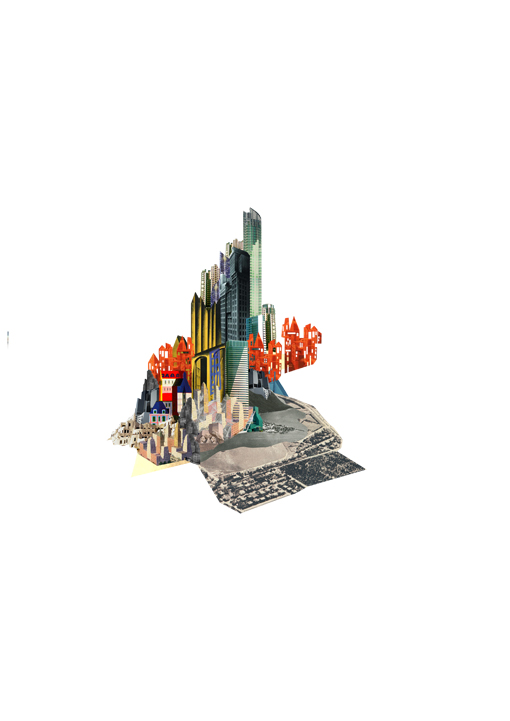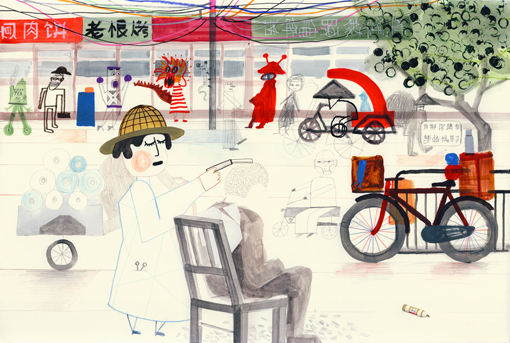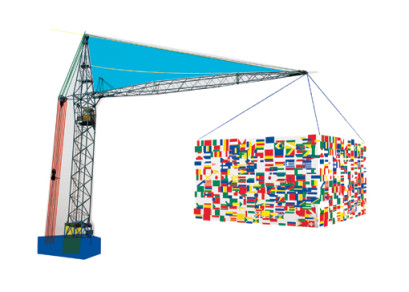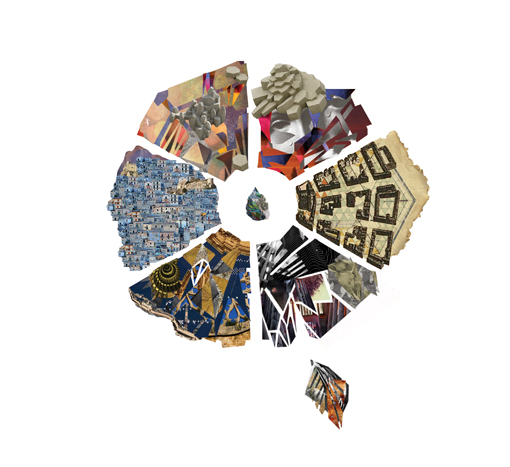The reality of the contradictory imaginary cities

text Sebastian Di Guardo illustrations Elisa Vendramin
I will build a round table where we can assemble.
And a vault on the table. And a castle on the vault. (King Arthur)
Many times I’ve imagined to found a city, in particular when I was an adolescent; I drew it on a sheet of paper, before “Empire” or “ Sim City” and the most difficult thing was always the first stroke of the pen. The sentence of the Arthurian cycle, previously cited, reports the foundation of the legendary Camelot and I have always been impressed by it because it was very different from the myths diffused throughout the ancient peoples. Common features with these are the creation of a “centre” and the founding of a new law, whilst what is missing is the figure of a sacred animal, as an intermediary with the divinities, that suggests a predestined place. Ancient cities were founded fencing common territory subtracting it from nature or others, thus that act had to be justified by a divine will. The result is that everything that is inside the walls is “fair”, “good” : it’s the mentality of the conqueror, of the ancient Roman disgusting in its hypocrisy, far from that of a compelling narrator/ bard for which the raison d’être of the city are the stories that evoke passion and unity. The limitation of this thinking lays in the fact that it is based solely on men, fallacious ground. Conspiracies and greadiness will be the cause of the flip side of the Arthurian cycle, from the epic theory of duals and magic to stories of sorcery, deception, filicide / patricide. It is no coincidence that the desperate knights depart in search of the Holy Grail, the divine principle. The two models complement each other well: walls and the ability to be a team are not enoughyou also need rituals that give a deeper meaning to things. Without all that, we will never have a living city, we will have an archaeological city instead: infact flourishing cities have often been abandoned due to dramatic self destructive events. Man constantly oscillates between two souls positive and negative, and so lies between oblivion and glory, and it is the city that instantly absorbs these contradictions. It is for this reason that many cities have different or even opposite reputations, for example New York is identified in the same way with Metropolis and Gotham City, imaginary metropolis that are substantially different. Metropolis is daytime N.Y. for the famous director Frank Miller or NY from upper 14th street for the writer Dennis O’Neill , it is the wonderful city of progress, future and opulence. Superman is the hero who embodies the supernatural and unwavering heart of an honest and industrious society placed in front of the snares of evil personified in dishonest, insane and corrupt politicians: icon of the United States near war in 1938. It is ultimately a very boring city as it is fake, whose architectures are “1930s architecture stretched like a rubber band”.
Vice versa New York in opposite conditions can be associated to Gotham City, and the charm that it spreads is that of the ambiguous city night life, where crime is rampant in the streets, no morality is able to assert itself on the law of the jungle. The streets of Gotham, the Wayne Enterprise Building, Cathedral, create, especially on the sets of A. Furst for T. Burton a complex space, recalling the German Expressionism in forms such as the desire to get a dark, metallic and rhetorical scenario: the same result is reached by A. Feininger in his dramatic and stunning pictures in black /white NY ‘30s and ‘40s, a time/symbol of the fracture that now exists between civilization and nature, especially for artists. They “represent a silence” which is nothing more than an inability to communicate. In this distressing and cruel picture, where the frightened citizens can do nothing but take refuge in the safety of their homes and the police is corrupt and absent, the deuxs ex machina intervenes, that is the super hero who achieves a superhuman identity,magnificent in his new racing car and his sci-fi gadgets.
Nevertheless, the inalienable human contradiction emerges in the advent of new super-villains and is then metabolized by Batman himself, who carries the burden for everyone. Contrarily to Superman he is just a man, and as such he is subject to errors, temptations, falls. The inevitable result is the emergence of a personal morality and questionable as such. That’s what happens to a greater extent in Vigata in the novels of Andrea Camilleri’s “series of Montalbano”. These stories are always hovering between detective fiction and noir, they indeed seem to generate a new genre that blends them. Vigata is a city full of smells, tastes, baroque architecture, it is the image of the Sicilian city where the present is so soaked in the past that crossing a door you may find yourself in the last century, with the objects, characters and the mentality of the century last; a simulation so real that the tv series is able to recreate in the locations of Puntasecca, Siracusa, Modica, Porto Empedocles. Camilleri doesn’t renounce either the acute deduction or the ambiguity that occurs between a rich culture of gestures, beauty, and a murky and criminal background. These aspects often coexist together bringing the common mentality that loses the thread of good/evil and accepts what is wrong as “normal”, just like in a noir novel. For this Montalbano is absolutely not a solver -there is nothing that can be solved- it is infact beauty that solves everything, that what is missing in Gotham City.
Montalbano in Gotham would be nothing more than what Hartigan was in Sin City, the famous Hard Boiled genre graphic novel. The colors are gone, the night is eternal and the sky thunders menacingly as a divine curse. The protagonist is an antihero often violent, misogynist, a charming “hard.”
Evil has prevailed becoming a slimy and inhuman extreme. The good guys have mingled with the abyss just for the sake of fighting it. It is this extreme condition that allows us to distinguish the real from the imaginary, even though it has cost our good side to tremble and the bad side to wallow in it. It may even be mans ambiguity that creates reality as it is, his showing himself just as he is, and it is the collision of these two sides that like a vortex creates reality, the real city. The victory of one of the two fronts, as in imaginary cities, is superficial and ephemeral, or otherwise forced and unnatural. It is therefore important to take part in the discussion, take part: which implies the development of taste (and dis-taste) which is the whole sense of art, authentic Dante’s Virgil in the range of human feelings. Unfortunately everything seems to give way to anonymity, “practicality” and superficiality, then to the apathy that entails forgoing the wonder, the ability to recognize everything that can be beautiful-or disgusting, or ambiguous-in our cities: everything that makes them livable and tangible.
“Harmonie et Contraste, toute Beauté procède de ces deux éléments”
(Vatel)
Molte volte ho immaginato di fondare una città, specie da adolescente; la disegnavo su un foglio di carta, prima di “Empire” o “Sim City” e la cosa più difficile era sempre mettere il primo tratto di penna. La frase del ciclo Arturiano citata in precedenza riporta la fondazione della leggendaria Camelot e mi è sempre rimasta impressa perché molto diversa rispetto ai miti diffusi presso i popoli antichi. Caratteristiche comuni con questi sono la creazione di un “centro” e lo stabilire una legge nuova, mentre è assente la figura di un animale sacro indicante il luogo predestinato, un tramite con la divinità. Le città antiche venivano fondate recingendo territorio comune sottraendolo alla natura o ad altri, quindi tale atto doveva essere giustificato da una volontà divina.
La conseguenza è che tutto ciò che sarà dentro le mura sarà “giusto”, “buono”: la mentalità propria del conquistatore, dell’antico romano, disgustosa nella sua ipocrisia, tutt’altro rispetto a quella avvincente del narratore/aedo per il quale la ragion d’essere della città sono i racconti che suscitano passione e unità. Il limite di questo pensiero sta nel basarsi solo sull’uomo, terreno fallace. Saranno i complotti, la bramosia a provocare il rovescio della medaglia del ciclo arturiano dall’epica teoria di duelli e magie a storie ripugnanti piene di stregonerie, inganni, figlicidi/patricidi. I cavalieri disperati partono non a caso alla ricerca del Sacro Graal, del principio divino. I due modelli si completano così a vicenda: non sono sufficienti delle mura e la capacità di fare gruppo ma occorrono anche dei riti che diano un significato più profondo alle cose. Senza tutto ciò, non avremo mai la città viva, ma la città archeologica: è infatti da drammatici eventi auto-distruttivi che spesso deriva l’abbandono di città anche fiorenti. L’uomo nel suo oscillare perpetuo tra due anime positive e negative si trova tra il baratro e lo splendore, ed è la città che ne assorbe istantaneamente le contraddizioni.
È per questo motivo che molte città hanno reputazioni diverse o addirittura opposte nell’immaginario: per esempio New York viene identificata allo stesso modo con Metropolis e con Gotham City, metropoli immaginarie sostanzialmente differenti. Metropolis sarebbe la N.Y. diurna per il famoso regista Frank Miller oppure N.Y. dalla 14° strada in su per lo sceneggiatore Dennis O’Neil, essa è la meravigliosa città del progresso, del futuro, dell’opulenza. Superman è il suo eroe che incarna il cuore soprannaturale e incrollabile di una società onesta e operosa posta di fronte alle insidie del male personificato in politici disonesti, pazzi e corrotti: l’icona degli USA prossimi alla guerra nel 1938. È in fin dei conti una città molto noiosa poiché finta, le cui architetture, sono “ 1930s architecture stretched like a rubber band”. Viceversa New York nelle condizioni opposte è associabile a Gotham City, e il fascino che propaga è quello ambiguo della notte cittadina, della malavita imperante nei vicoli ove nessuna moralità è capace di affermarsi sulla legge della giungla. Le strade di Gotham, il Wayne Enterprise Building, la Cattedrale, realizzano soprattutto nelle scenografie di A. Furst per T. Burton uno spazio complesso, ricordando l’Espressionismo tedesco nelle forme come nella volontà di ottenere un effetto cupo, retorico e metallico: lo stesso risultato viene raggiunto da A. Feininger nei suoi drammatici come sbalorditivi bianco/neri di N.Y. anni ’30 e ’40, un’epoca/simbolo della ormai insanabile frattura tra civiltà e natura soprattutto per gli artisti. Costoro “rappresentano un silenzio” che non è altro che incapacità di comunicare. In questo quadro desolante e crudele, dove i cittadini impauriti non possono che trincerarsi in casa e la polizia è assente e corrotta, interviene il deus ex machina cioè il supereroe capace di ottenere dalla propria maschera una nuova e sovraumana identità, magnifico nel suo bolide e con le sue attrezzature fantascientifiche.
Ciò nonostante l’inalienabile contraddizione umana riemerge nell’avvento di nuovi super-cattivi e infine viene come metabolizzata da Batman stesso, che se ne fa carico per tutti. Al contrario di Superman egli è solo un uomo, e come tale nel suo cammino è soggetto a errori, tentazioni, cadute. L’immancabile risultato è il sorgere di una moralità propria e come tale discutibile. È quello che succede in modo più esteso a Vigàta nei romanzi di Andrea Camilleri della “serie di Montalbano”.
Questi racconti sono sempre in bilico tra giallo e noir, anzi sembrano quasi generare un nuovo genere che li fonde. Vigàta è una città ricca di odori, sapori, architetture barocche, è l’immagine della città siciliana dove il presente è così intriso di passato che varcando un portone ti puoi trovare nel secolo scorso, con gli oggetti, i personaggi e la mentalità del secolo scorso; una simulazione così perfetta che la serie televisiva la concretizza perfettamente nelle location di Puntasecca, Siracusa, Modica, Porto Empedocle. Camilleri non rinuncia alla deduzione acuta così come all’ambiguità che si genera tra una cultura ricca di gestualità, di bellezza, e un retroscena torbido e criminale. Questi aspetti convivono a braccetto spesso tirando in ballo la mentalità comune che perde il filo del discorso bene/male e accetta ciò che è sbagliato come “normale”, proprio come avviene nel romanzo noir. Per questo Montalbano non è assolutamente un risolutore – non c’è nulla che possa risolvere – ma è proprio la bellezza a salvare tutto, quella che manca in Gotham City. Montalbano a Gotham non sarebbe altro che Hartigan a Sin City, la celebre grafic novel di genere Hard Boiled. I colori sono scomparsi, la notte è eterna e il cielo tuona minaccioso come una maledizione divina. Il protagonista è un antieroe spesso violento, misogino, un affascinante “duro”. Il male ha prevalso arrivando all’estremo viscido e inumano. I buoni si sono mischiati all’abisso pur di combatterlo.
È proprio questa condizione estrema a permetterci di distinguere il vero dall’immaginario, non senza che il nostro lato buono abbia tremato mentre il cattivo si crogiolava all’idea. A realizzare la realtà potrebbe essere proprio l’ambiguità dell’uomo, il suo mostrarsi così com’è, ed è lo scontro continuo tra i due fronti come un vortice che dal proprio movimento genera il reale, la città vera. La vittoria di uno dei due fronti, come avviene nelle città immaginarie, è superficiale e caduca, o altrimenti forzata e innaturale. È quindi importante prendere parte alla discussione, partecipare: il che implica l’educazione al gusto (e al dis-gusto) che è proprio dell’arte, vero Virgilio dantesco nella gamma dei sentimenti umani. Tutto ciò purtroppo sembra cedere il passo all’anonimato, alla “praticità” e alla superficialità, quindi a quell’apatia che comporta la rinuncia alla meraviglia, capacità di riconoscere tutto ciò che può essere incantevole – o disgustoso, o ambiguo – delle nostre città: tutto quello che le rende vive e tangibili.
“Harmonie et Contraste, toute Beauté procède de ces deux éléments”
(Vatel)
Related Posts :
Category: Article
Views: 4440 Likes: 1
Tags: cityvision mag , elisa vendramin , Gotham City , imaginary cities , Metropolis , Modica , Porto Empedocle , Puntasecca , Sebastian Di Guardo , Sick & Wonder , Siracusa
Comments:
Info:
Info:
Title: The reality of the contradictory imaginary cities
Time: 8 marzo 2013
Category: Article
Views: 4440 Likes: 1
Tags: cityvision mag , elisa vendramin , Gotham City , imaginary cities , Metropolis , Modica , Porto Empedocle , Puntasecca , Sebastian Di Guardo , Sick & Wonder , Siracusa







